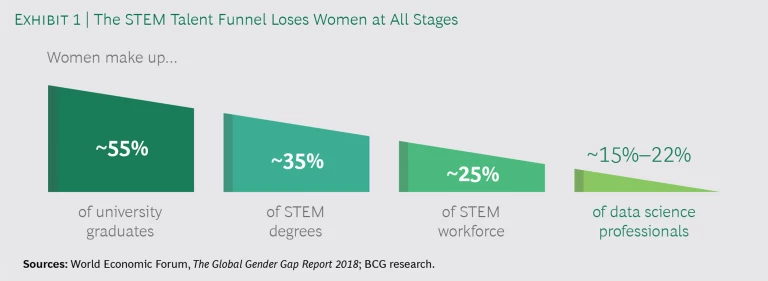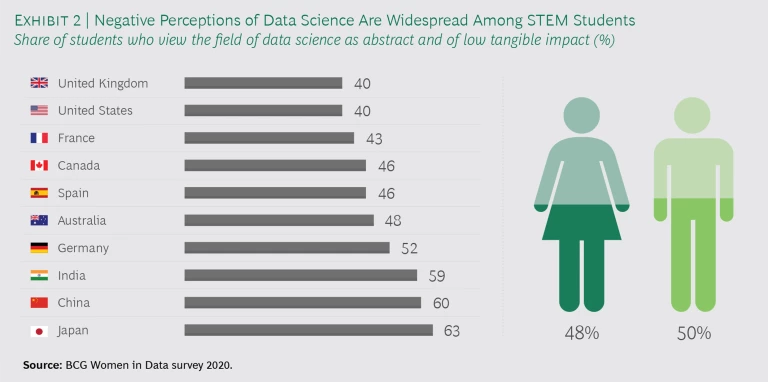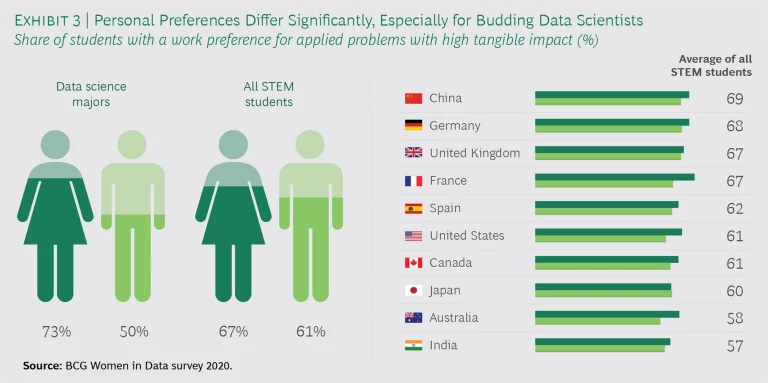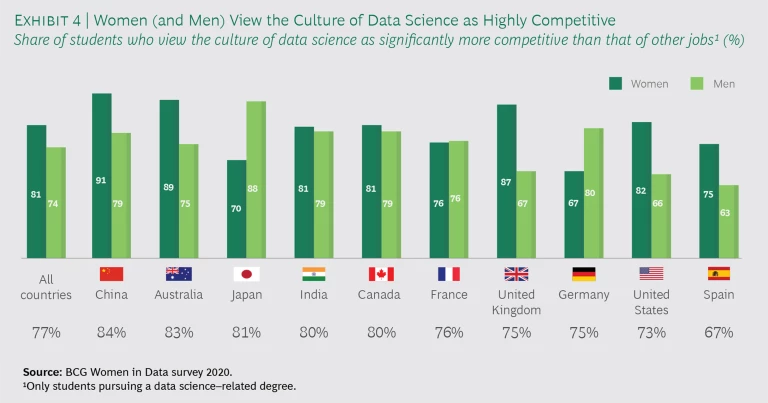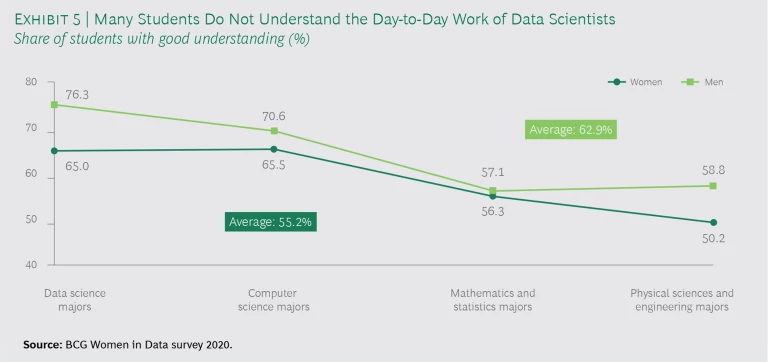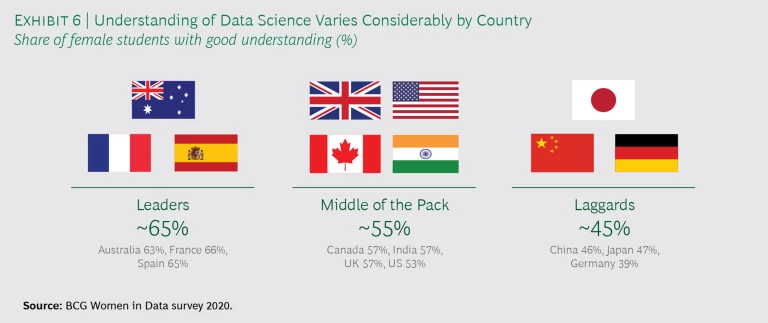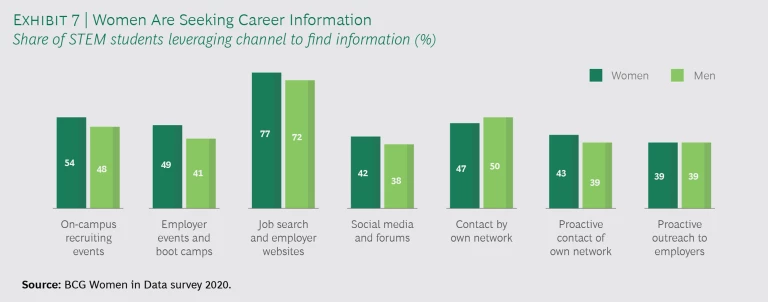Data science has an image problem. Companies are increasingly looking to hire the best and the brightest in this field, but to many talented young people, it’s not an attractive career option. There is a widespread perception among STEM students that data science, the rapidly growing field behind the artificial intelligence (AI) and big data revolution, lacks purpose and promotes an unappealingly “nerdy” work culture. These perceptions—some of which, unfortunately, reflect the state of data science in many companies—have a disproportionate impact on the career choices of female students.
The consequence is a lack of diversity: as few as 15% of data scientists today are women. And that lack of diversity is a serious issue. AI algorithms are susceptible to bias, so building them requires a team that includes a wide range of views and experiences.
Companies cannot rely on the hype around AI to fix the problem.
Companies cannot rely on the hype around AI to fix the problem. They must urgently understand what steps they can take to prevent talented students—in particular, qualified women—from walking away from the field. A new BCG survey of more than 9,000 STEM students from ten countries sheds light on the gender gap in data science hiring. (See “About the Study.”) We focus on the criteria STEM students use to assess their career options in order to identify what drives their decision to pursue (or not to pursue) a career related to data science, to understand differences across countries, and to examine what employers can do to encourage more female students into the field.
About the Study
About the Study
In August and September 2019, BCG conducted an online survey of STEM students—university students majoring in a science, technology, engineering, or mathematics field—as well as recent STEM graduates. The survey sought to explore the parameters of STEM students’ initial career decisions, their perceptions of data science as a potential career path, and the way perceptions and preferences interact to influence their first job choice.
BCG surveyed more than 9,000 STEM men and women from Australia, Canada, China, France, Germany, India, Japan, Spain, the United Kingdom, and the United States (with 700 to 1,000 responses from each country).
Respondents were restricted to people under the age of 35 who either were completing a university STEM degree at the local equivalent of Bachelor, Master, or PhD level (about one-third of the sample population) or had recently completed a STEM degree and had entered the workforce (about two-thirds of the sample population). For many questions, the recent graduates were asked to reflect on their state of knowledge and perception of data science during their time as students.
Among respondents already in the workforce, nearly 1,400 work in a data science–related role, such as data scientist, analytics architect, data engineer, machine learning engineer, analytics software engineer, or analytics UX/UI engineer. Their employers represent a diverse mix of company sizes and industries.
Diversity Is Critical to Data Science
Data science—the harnessing of big data, advanced analytics, and AI—will soon be everywhere. The days when data science was restricted to the R&D departments of technology companies and ambitious startups are long gone. Today, organizations across the private and public sectors are scrambling to come to grips with its transformative potential and are rapidly building up the necessary know-how. Data scientist, data engineer, machine learning specialist, analytics software engineer: these data science–related roles are in high demand.
In building data science teams, achieving a diversity of approaches and points of view is not just desirable—it is critical. Interpreting causal relationships and correlations in large data sets requires subtlety, and both humans and machine learning algorithms can occasionally “see” patterns that lead to spurious, biased, or even downright dangerous conclusions. AI algorithms that are trained on historical data points (such as a company’s past hiring decisions) are susceptible to learning and perpetuating existing biases. Building such algorithms can be just as much an art as a science. In particular, as BCG’s May 2019 article “How AI Could Help—or Hinder—Women in the Workforce” argues, it takes a diverse team of men and women to ensure that models that are susceptible to biases produce accurate, balanced results.
But data science, like most STEM fields, still has a daunting gender diversity problem. While women make up, on average across countries, around 55% of university graduates, they account for just over one-third of STEM degrees. (See Exhibit 1.) From this precious talent pool, only two-thirds go on to a career in a STEM-related field such as engineering, analytics, or software development, and even fewer move into a career in data science. Consensus across various surveys is that only about 15% to 22% of all professionals in data science–related roles are women.
For companies hiring STEM students into tech and analytics roles, this is a very real constraint on talent. As the impact of data science and AI-driven decision making becomes ever more ubiquitous, it has the potential to become a very dangerous problem—not just for individual companies, but for entire markets.
The dynamics of the talent funnel shown in Exhibit 1 are complex and multifaceted, driven by issues ranging from the biases that can turn girls away from mathematics and science in secondary school to the many factors surrounding advancement and retention of women in the STEM workplace.
Employers seeking to recruit data scientists from universities into this rapidly growing field sit in the middle of this funnel, struggling to ensure that their applicant pool is filled with the best mix of top female and male candidates. Many have begun to address the gender imbalance of their intake by looking inward: reexamining their recruiting and HR policies, eliminating selection biases in the screening and interviewing of candidates, realigning pay levels for new hires, and rethinking the role of mentorship and sponsoring. (See BCG’s November 2018 report, “Winning the Race for Women in Digital,” for a detailed discussion of such efforts.) These are valuable and important steps.
Often overlooked in this discussion, however, are the factors that can cause qualified STEM students not to even consider applying for a job in a field like tech or data science. Students whose personal career radars do not include data science (because of a lack of appeal or a basic lack of information) are lost to employers before such inward-facing diversity measures can help. Understanding how employers and universities can influence and broaden the scope of students’ career considerations—and remove any inherent gender barriers—is therefore of critical importance.
Data Science Has an Image Problem
Back in October 2012, Harvard Business Review named data scientist as “the sexiest job of the 21st century.” Over the past decade, new job creation in the field has accelerated at a tremendous pace, and data science has consistently placed high in student rankings of attractive careers. Today, with the likes of Amazon, Google, and Apple regularly in the press with stories of rapid advancements in artificial intelligence and next-level insights gleaned from massive data sets, it is easy to assume that data science opportunities must now appear prominently on the personal career radars of almost all STEM students.
Our study shows, however, that the picture is more mixed than one might assume. A very significant share of STEM students across countries appear to have a less than positive view of the work content and culture of data science. Their view, interpreted bluntly, is that data science feels abstract and without sufficient purpose, and that the culture seems overly “nerdy” and competitive. The direct and natural consequence of these perceptions for many will be to push data science opportunities to the fringes of their career radars—or to have them drop off the radar entirely. Critically, this adverse self-selection disproportionately impacts the choices of women and directly hinders diversity.
Data Science Can Feel Abstract and Without Purpose
Data science, done well, is as applied and consequential as it gets. Indeed, many real-world applications are all around us: We come into contact with the power of data science every day as consumers when we go shopping, watch TV, drive our car, or interact with our utilities provider. AI can help producers and service providers to better understand and anticipate needs, to deliver faster solutions, and to boost efficiency. Many of the conveniences we take for granted today—from online retailers to Google Search to smartphones—are unthinkable without data science and AI.
A surprisingly large share of students, however, do not have a positive perception of the field. In our survey, only around half of all STEM students agreed with the view that a data scientist spends his or her time solving real-life problems with high tangible impact. For 49% of students overall (48% of women, 50% of men) in the countries surveyed, the field is instead seen to be theoretical and abstract, focused on manipulating code and data with low impact and, by implication, low purpose. (See Exhibit 2.) Similarly, 68% of students overall subscribed to the view that data science problems are narrow and limited in scope, with little room or need for big-picture thinking. Students who share this view of data science—both men and women—are inherently at risk of dropping out of the talent funnel for data science jobs.
There are probably multiple factors at play. Some of this negative image may be due to misperceptions that can result from university curricula that feel abstract to students if too much emphasis is placed on theoretical constructions and too little on practical examples. Some may also be due to asymmetric media coverage that creates a buzz around cutting-edge breakthroughs while underreporting many remarkable but “quieter” advances in analytics and AI.
First and foremost, however, such perceptions are shaped by companies themselves. Students are picking up on the reality that not all companies are, in fact, succeeding at creating tangible impact from data science and AI. Many companies continue to lack a coherent strategy for how data science and AI can begin to transform their businesses: they “let a thousand flowers bloom” in the hope that a few of these many ideas might take off, but they pay for the occasional success with a long list of disappointing failures and low-impact initiatives. (See the October 2019 MIT Sloan/BCG joint report “Winning with AI” for details on what differentiates leading companies from those falling behind on AI.) And in their direct interactions with students, many companies struggle to communicate a plausible and inspiring vision for the importance, impact, and purpose of data science within their business. Many students are unconvinced.
Students are picking up on the reality that not all companies are, in fact, succeeding at creating tangible impact from data science and AI.
These negative perceptions are present across countries. China (one of the global front-runners in AI activity within companies), Japan, and India are the clear negative outliers on this dimension, with around 60% of students of the view that data science is abstract and with little application. The UK and the US lead the perception ranking, though still with a significant 40% of students taking a negative view of impact and purpose.
These Perceptions Disproportionately Deter Women
Across the countries represented in our survey, there was no meaningful difference in perception along gender lines on average: STEM men and women broadly shared the same perceptions in equal measure. They did not, however, share the same preferences, and for this reason, data science’s image problem becomes a diversity problem: the impact on women’s choices regarding data science is amplified.
Personal working preferences will naturally vary from one student to the next. While some Millennials and Gen Zers may seek applied work with direct real-world impact, others prefer conceptual work with a narrow focus that allows them to “go deep” without expecting any directly measurable value to go with it.
On average, however, our results show that STEM women place a higher premium on applied, impact-driven work than men do: 67% of women expressed a clear preference for such work, compared with 61% of men. Within the sweet spot for data science hires—students majoring in data science or machine learning—the difference in preferences is even more clear-cut, with 73% of women and 50% of men prioritizing tangible impact in their career choice. (See Exhibit 3.)
Here, perceptions and personal preferences intersect in a critical way. A career path that is perceived to be abstract, low-impact, and without strong purpose is significantly less attractive to STEM women than it is to their male peers. With half of female students sharing this perception, a large portion of the female STEM talent pool is therefore at high risk of neglecting data science as a potential “fit” for their personal preferences and expectations. For an industry desperately seeking greater diversity, this is a “double whammy.”
A career path that is perceived to be abstract, low-impact, and without strong purpose is significantly less attractive to STEM women than it is to their male peers.
Just as perceptions vary across countries, so do students’ personal work preferences (influenced, to be sure, by a range of cultural and economic factors). In China and Germany, whose share of negative perceptions was among the highest, the threat of adverse self-selection among STEM women is particularly large: STEM women in these countries also have the strongest personal preference for high-impact work and are therefore at greatest risk of being turned off by data science’s negative image. In Japan and India, also high on the negative perception ranking, the situation is equally dire, though women’s work preferences are less pronounced. Despite the nuances, however, the high value students place on tangible impact and purpose—and the relative higher value placed by women—is effectively universal across countries.
Data Science Feels Competitive and Non-Inclusive to Many
The impact of negative perceptions extends to views of company culture. Students rightly spend a lot of time considering the work culture in their chosen field. Will it be hyper-competitive or broadly collaborative? Does the field as a whole promote diversity and inclusion? Are mentorship structures available to support personal development? On these dimensions, when it comes to recruiting students, perceptions are vitally important.
Our survey shows that many STEM students are concerned about the interpersonal competitiveness of data science jobs—that is, the degree to which employees work in competition with one another rather than as part of a collaborative team. Averaged across countries, 81% of women (and 74% of men) pursuing a data science–related degree perceived the field as being “significantly more competitive” than other types of jobs. (See Exhibit 4.) In China, Australia, the UK, and the US, the share of women with this perception was even higher, with 91% of Chinese women pursuing a data science degree seeing high competitive pressures within the field’s work culture. With “male-dominated competitive culture” topping the list of concerns about data science for many female students considering the field, this perception can clearly have a very real impact on students’ choices.
While most practitioners might argue that data science is, by its nature, a collaborative endeavor, it is perhaps not surprising that many students view data science from a competitive angle. Here, again, students are simply picking up on the signals that many companies actively convey. For example, many employers contribute to cultivating this perception by promoting student performance in coding competitions as a key performance indicator on job applications, even when the day-to-day work of data science in these companies is not competitive in this way. Company-hosted “hackathons”—recruiting events intended to bring together aspiring data scientists in a fun, “let’s code together” environment—can quickly devolve into a boiler-room atmosphere where students feel tested and scrutinized, rather than engaged and inspired. For many students (and above all many women), these environments can be off-putting and can be a disincentive to further exploration of data science as a career option that might match well with their own personal preferences.
Communication Is Critical But Lacking
To combat these perceptions of the field, active information sharing by the data science community is key. While universities can play an important role in doing more to spotlight real-life use cases in their curricula, it is really up to employers to paint a picture of data science jobs that will address the concerns, dispel the myths, and help data science become a tangible career option for more STEM women. On this front, companies can and must do more.
Students Feel Poorly Informed
Our survey explored not only perceptions and preferences, but also how much basic knowledge students feel they have about the career opportunity. The results reveal that a significant share of STEM students internationally do not feel that they have a good understanding of what a “data science career” even is, what career development options it can offer, and what the day-to-day work of a data scientist entails. Overall, only around 63% of men and 55% of women felt adequately informed about the various career opportunities involving data science. (See Exhibit 5.) Only 61% of men and 55% of women understood the qualifications required for a data science role; and only 62% of men and 47% of women were aware of the career paths in the field. Even among data science and computer science majors, who are naturally closest to the topic, 35% of women felt that they have a poor understanding of the day-to-day work of a career data scientist, and nearly half (47%) decried poor clarity regarding related career paths.
It should come as no surprise that the aspects of transparency noted above are significantly correlated with STEM students’ career decisions. Students will consider a career only if they have a good understanding of the opportunity and its implications for them (even when it is heralded as “the sexiest job of the 21st century”). In our survey, nearly 24% of former students with a good understanding of the opportunity had taken a job in a data science–related field (data engineering, analytics software development, machine learning, or similar roles). Of the students whose understanding was poor at best, only 12% had gone on to work in the field.
Among STEM students, data science career transparency varies significantly across countries. In our survey, a cluster of countries—Australia, France, and Spain—sets itself apart by consistently achieving high rankings across key dimensions of transparency: understanding of the workplace role, the necessary qualifications, and longer-term career path options.
At the other end of the spectrum, female students in China, Japan, and Germany consistently reported the lowest transparency about their options in this field, with only about 45% feeling sufficiently well informed and, correspondingly, about 55% at risk of being directly lost from the potential talent pool because of a basic lack of information.
Companies Are Reaching STEM Women—but Not with Facts They Need
One might ask whether companies are, perhaps, simply not reaching out enough to STEM students (or to women in particular). Across countries, however, there appears to be no shortage of opportunities to provide students with tangible career information on data science, to dispel negative perceptions about the work culture, or to share real-life use cases that demonstrate purpose. STEM students are a coveted talent pool and, as such, are actively wooed for data science- and tech-related jobs. Indeed, 76% of STEM students felt that they were being approached more actively and more intensively by employers offering data- and tech-related roles than by all other kinds of employers. In short: companies are reaching out.
STEM women feel that they are being engaged by these companies just as intensively (if not more intensively) than their male counterparts. A larger share of women than men reported engaging across the channels used by potential employers to interact with students, including on-campus recruiting events and company “boot camps,” homepage-based marketing and job websites, social media, and formal and informal “people networks.” More than half (54%) of STEM women reported engaging with companies offering data or tech jobs through on-campus events, while 77% sought information about such jobs by visiting employer and job search websites. (See Exhibit 7.) Across channels, women’s engagement lagged that of men only in “being reached out to” by an existing network—which is not surprising, given the selection bias that accompanies personal work networks, especially in a young and still male-dominated field.
But women in particular feel that critical information is missing. In our survey, STEM women clearly ranked three information areas regarding data science as being the most important to them by far. While relevant to many fields, they appear to be particularly critical for a young, rapidly evolving field like data science.
1. Clearer communication of what the day-to-day job is really like. While many students learn about the tools of data science at university, there are often no points of reference for what applying those tools on the job would actually mean. STEM women are hungry for tangible details about the content of data science work that companies do: real-life examples and actual use cases. In particular, students are keen to understand the impact that their work would have and the purpose it serves.
2. More opportunities to connect with actual practitioners. Like many other tech fields, data science need to ensure that students are not left to stew in their negative perceptions and concerns about work culture, non-inclusion, and competitiveness. If not tackled head-on through direct communication, these perceptions can fuel a self-fulfilling prophecy. STEM women want and need a direct feel for the personalities, the ways of working, and the degree of collaboration. This feeling rarely comes across in a corporate slide show or through a marketing-heavy internet presence.
3. Clearer communication of the qualifications required for the job. Students are frequently alienated by overexcited data science job descriptions that seem to be seeking unicorns: people with exceptional technical skills, multiple programming languages, outstanding communication skills, and plenty of prior experience to boot. It can seem to students that “being strong in data science” is not enough. As various studies have shown, such unrealistic expectations disproportionately dissuade women from applying, while men are often more willing to take a chance even when the bar is set unreasonably high.
“More networking events” and “Stronger tailoring of events to different groups of students”—for instance, more women-only events—were both ranked low. It appears that STEM women believe that there already are enough opportunities to engage with employers. Rather, the problem is that employers are not making the most of the opportunities to address the issues that these women care about most.
Companies Must Do More
Companies are not doing enough to fill these voids. Simply relying on the media buzz and hoping for data science to “sell itself” to students is naïve and will only perpetuate poor diversity. Companies must work harder to combat the negative perceptions of the field and the lack of tangible information about career paths that both male and female students feel—but that disincentivize women much more strongly. For many companies, this will require both internal action (within their own data science teams and company cultures) and changes to their external communication (in the way that they present themselves online and reach out to students).
Changing Perceptions by Changing the Reality
The best way to change the negative perceptions dogging data science is to demonstrate that they are untrue. To be attractive to the data science talent of tomorrow, companies should focus today on ensuring that their analytics and data strategy prioritizes measurable impact, focusing their efforts on the handful of initiatives that can and will deliver significant value and sharing the successes that result with the community. One key ingredient is a company culture that actively celebrates concrete business impact from data science, not just abstract improvements to model performance and the number of patents granted. Equally important is a culture that promotes impact through collaboration and teamwork and that frowns on “my model is stronger than your model” competitiveness.
The best way to change the negative perceptions dogging data science is to demonstrate that they are untrue.
When companies actually live this kind of collaborative, impact-driven approach to data science and AI from the most senior levels downwards, it shows. It requires integrating AI strategy with business strategy to create a common purpose, and it demands bold willingness to take on projects with big impact even if they are large and risky. For established companies, this change of approach and tone often doesn’t come easily: it takes clear leadership on AI and data science at the highest levels. But as more and more companies come to live in this paradigm, perceptions will begin to change, systematically reducing barriers to more diverse recruiting.
Communicating More Effectively with Female Students
The most immediate way for companies to combat negative perceptions and to provide the information that students lack is, of course, to engage with them directly on these topics. As noted above, companies are already reaching out to STEM students, but it appears that the content is often too generic, too undifferentiated, or insufficiently focused on the questions and concerns that trouble women in particular. While this may, at some level, hold true for many STEM fields, both the scale of the diversity problem and the scale of the image problem in data science make targeted action all the more pressing.
In their communications at recruiting events, on social media, on job portals, and on their own websites, employers should do the following to get their organizations on the career radars of STEM women:
- Make data science tangible by bringing detailed examples of the types of business problems that the company’s data scientists solve and by showing what day-to-day work on such problems would look like for a new joiner.
- Make data science relatable by bringing actual data scientists to events (instead of only recruiting staff) and by presenting current employees’ stories on the company website in the form of interviews or vignettes, making sure that these employee snapshots represent experiences relatable to both men and women.
- Make requirements honest by publishing realistic job descriptions (written by data scientists, not by HR) that inspire qualified students to apply even when they are not fully sure of their chances of success.
- Make “selling” data science sensitive to different perspectives by being conscious of format, tone, and language about events like hackathons, which may not appeal to everyone in the same way.
Simply changing the tone and content of the conversation might appear to be simple measures, but in a battle for talent that hinges on students’ perceptions and preferences, they can play an important part in helping to correct the gender imbalance in the STEM funnel. In combination with the other end-to-end actions highlighted in BCG’s “Winning the Race for Women in Digital” report—including sponsorship and flexible work—there is a wealth of concrete steps that senior managers can take to improve diversity.
As long as companies struggle to present data science as a field that is attractive to all students (not just to some), a large share of the female talent pool will continue to vote with their feet and avoid the field altogether, perpetuating the lack of diversity in this increasingly mission-critical part of companies’ workforces. Managers must take action now to create a working culture in their analytics functions that appeals to all students and emphasizes the underlying purpose and business impact. And managers must ensure that their companies are conveying this sense of purpose and impact directly to the students they are hoping to recruit. With the need for data science talent and robust AI solutions growing ever faster, there is no time to lose.

